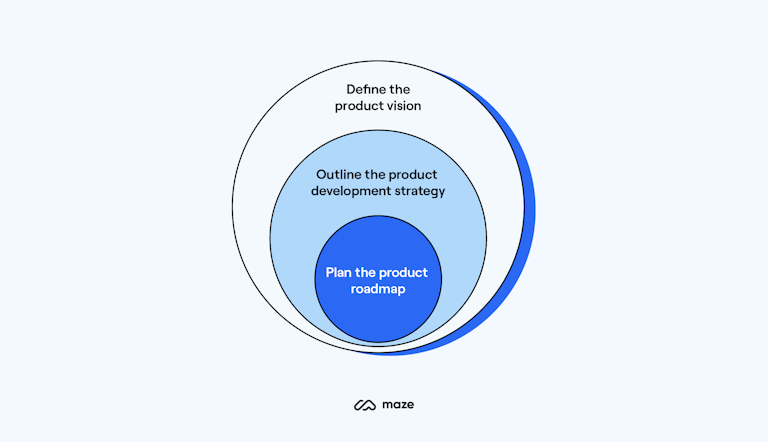To stay competitive, companies need to find new ways to innovate and deliver continuous value to their customers. Yet creating winning products requires more than an innovative idea. Careful planning and strategy are a must for success. You'll need a clear direction to follow to optimize resources, identify priorities, and ensure a smooth product development process.
In this article, we’ll look at what a product development strategy is and how you can develop a great one for your product. For expert insights and best practices, we spoke to Vicky Volvovski, Senior Director & Head of Product Management at Postlight and former Head of Product at Zapier; Enzo Avigo, Co-founder & CEO at June and former Product Manager at Intercom, Zalando, and N26; and Ian Booth, Senior Product Manager at EduMe.
What is a product development strategy?
A product development strategy is a fundamental part of the new product development process (NPD). It’s a high-level plan that describes the actions needed to develop new products or upgrade existing ones and introduce them to current or new markets.
New product development strategies link together the product vision and the strategic steps to realize that vision. In other words, a product development strategy guides a company's product development efforts—from concept to testing to launch—and aligns the new product's features and functionalities with the business strategy and target market needs.
The benefits of defining an effective product development strategy
Defining a product development strategy before you begin development is crucial. It will set the direction of your product and help you set clear goals. Let’s dive into the top three benefits of developing a strategy for your new product.
1. It gives you clarity
There are a million things that could get prioritized and a million directions that the product could go in. A product strategy allows you to say “yes” to the things that are aligned with your direction and say “no” to the rest.

Vicky Volvovski
Senior Director and Head of Product Management at Postlight
When you’re building a new product, deciding what to do, and most importantly, what not to do, is challenging. A product development strategy gives you a clear direction to follow. It helps you set priorities and make decisions that align with the company's overall strategy. "Sometimes the things you say 'no' to might be good ideas, but they don't align," explains Vicky. "That’s where product strategy gives you clarity."
2. It improves decision-making
The more your team can understand the strategy, the more they can make decisions in their day-to-day that help you reach that goal rather than having people pulling in different directions because they don’t understand what you're working towards.

Vicky Volvovski
Senior Director and Head of Product Management at Postlight
When goals and priorities are well understood, product teams can make better decisions throughout the development process. They will know what ideas are worth pursuing, what features they should prioritize, or how to adjust the plan if challenges arise. This brings us to the third benefit.
3. It maximizes product development efficiency
I think a clear strategy is really what differentiates the companies that move fast from the others. If you know what you want to achieve and communicate it clearly to your teams, they will be able to find the best way to reach the goal. It maximizes the time and energy of all the people who work in your company.

Enzo Avigo
Co-founder and CEO at June
When product teams have a well-defined strategy to follow, they can better manage resources, estimate timeframes and costs, and make quick, confident decisions. Enzo points out that a product development strategy not only is a way to optimize resources but it also keeps your teams motivated and your organization healthy.
Product development strategies and examples
Now that you know how a product development strategy can benefit your organization, let's look at three different types of strategies you can adopt and some real-life examples of product development strategies.
Data-driven product strategies
Being data-driven means making decisions based on data and key metrics. Data-driven companies break down the product development strategy into quantitative objectives to measure progress and success. What to measure and why usually depends on the company's high-level strategy. Product teams translate the high-level strategy into key metrics and generate initiatives to achieve the desired goals.
N26 is a company that adopts a data-driven approach to product development strategy. The company was founded with this vision: A global digital bank to transform the way we manage money.
“One of the ways to achieve our vision was to reach as many people as possible and increase our user base,” says Enzo Avigo, Co-founder of June and former Product Manager at N26. He and his team identified the metrics they wanted to move, such as the conversion rate and the number of active users, and worked on the main product initiatives to unlock those metrics.
Tip ✨
While data-driven companies use data to lead the decision-making process, data-informed companies acknowledge the limitations of data and use them to inform their decisions. Learn more about the difference between data-informed and data-driven.
Vision-driven product strategies
A vision-driven strategy starts with a view of the future—a clear picture of what the company wants to build. Innovation is driven by intuitive vision and personal goals rather than market research data. Founders of such companies rely on this type of strategy when they want to create truly innovative products and explore a market where users don’t know much about the new product and what features they’d like.
Yet “vision-driven” doesn’t mean that product teams won't use data. Insights and data are still needed to understand user behavior, test assumptions, or understand how to upgrade the product in the future.
Apple is one of the best examples of a company executing a vision-driven product strategy. Historically, Apple was known to build the products first and then find the market for them. In an interview, Steve Jobs explained: "We do no market research. We just want to make great products. When we created the iTunes Music Store, we did that because we thought it would be great to be able to buy music electronically, not because we had plans to redefine the music industry."
Research-driven product strategy
This third type of product strategy is based on market and user research. Product teams start the new product development process with product discovery and use research to inform their decision-making at all stages of the process. They reach out to users to understand their needs and expectations and based on data and user feedback, they determine how to build a product that satisfies those needs and delivers value to customers.
One example of a research-driven product strategy is Intercom. During his time as Product Manager at Intercom, Enzo Avigo worked in the platform group. The team was developing the Intercom App Store, where users can browse and install third-party apps and integrations. User research was crucial to figure out what to build. “We knew that the more integrations our users had, the better retention they had,” says Enzo. “We created the platform group to make sure that all the users could find the right app, for the right use case, at the right moment.”
While this is a "formal" distinction between different types of strategies, the most successful products employ a mix of these strategies: they are driven by data, do research, and have a clear vision of where they want to get to.
How to create a winning product development strategy
As we saw, there are different approaches to product development. But whatever strategy you choose, here are some simple steps to develop and execute a successful new product development strategy.

1. Define your vision
Your product development strategy is the bridge between your product vision and the actions needed to realize that vision. So, as a first step, you’ll need to clearly define where you want your product to go and what you want to achieve. In simple words, your vision communicates the intent behind your product and the high-level goal driving your product development.
Sometimes, companies use mission and vision statements interchangeably, but they have different purposes. A mission statement focuses on the here and now and what the company is doing to achieve its goals. A vision statement focuses on the future and where the company wants to be in the long run.
One example of a successful vision statement would be Google's: To provide access to the world’s information in one click.
2. Do your research
A successful product development strategy has to be rooted in real user problems and goals and a real market opportunity.

Vicky Volvovski
Senior Director and Head of Product Management at Postlight
The second step is to conduct in-depth research of your target audience, existing market, and competitors. In this way, you and your team can mitigate risks, use accurate data to inform your decision-making and increase your chances of building a successful product.
First, define and understand your ideal audience. Who are your target customers, and what problems are they facing? How will your product solve their problems? Interviews, surveys, or product analytics are just a few methods to get to know your users and identify their wants and needs.
Ian Booth, Senior Product Manager at EduMe, explains: "We have fantastic customer support and user research teams who constantly communicate with the customers and understand what they’re looking for from a strategy perspective. They’re so focused on being the champion for the user within the conversations that we’re having."
As a product manager, you're trying to balance the commercial side and the user side. You want to make sure that you’re not missing any information. Leaning on internal teams such as Customer Support and Research to champion the user's voice for me is the best route to go.

Ian Booth
Senior Product Manager at EduMe
Second, conduct market research and competitor analysis to learn what other products are available in the market, understand how users perceive your product compared to your competitors' offers, and identify what makes you unique. This is a fundamental step to decide how you will position and differentiate yourself in the market.
Tip ✨
Learn more about how market validation justifies product investment by assessing how viable your product idea would be in the market.
3. Set product goals
When you have a deep understanding of your target market, you should use the data gathered to establish a series of goals you want your product to achieve to deliver value to customers and gain a competitive advantage. Set SMART goals that are specific, measurable, achievable, realistic, and timely. They will help you decide what to build next and give you a tool to measure the success of your product.
We always have a really good objective to focus on and good key results to track success. If you’re able to set them early, track, and understand them, you can determine if your product launch is successful because you can see the actual progression.

Ian Booth
Senior Product Manager at EduMe
As part of our product development process at Maze, we always include a summary of our goals in the product development strategy document and regularly track our progress on every goal. This allows our product team to make decisions and align on the next steps.
4. Plan the product roadmap
It’s now time to define the initiatives, features, and releases that will help transform your goals into action. A product roadmap is a high-level visual that allows you and your team to execute the strategy. Product managers use roadmaps to plan tasks, communicate priorities, allocate resources, and see the evolution of a product over time.
A product development strategy ensures that all the initiatives in the roadmap are linked to the product’s vision and goals so that you can start development with a detailed and solid plan.
🎧 Learn how to balance intuition, analytics, and user feedback to make better product decisions & discover frameworks for building a clear product strategy in this podcast episode with Ravi Mehta, Co-Founder & CEO of Outpace. Tune in to The Optimal Path Podcast.
Looking for a comprehensive list of product management tools? Check out our list of the best 13 product management tools to streamline your workflow.
Final thoughts
We’d like to conclude with a piece of advice from Enzo Avigo, Co-founder and CEO at June:
Strategy is like chess. You can think for hours before you start the game, but nothing ever happens until you play. The same occurs with product strategy. The best thing to do is not to think about the perfect strategy but move a piece, build something, and see what it yields. So usually, building the easiest prototype or finding a way to validate your assumptions.

Enzo Avigo
Co-founder and CEO at June
Rapid prototyping can help you explore and validate ideas early in the product development process. With tools like Maze, you can test prototypes with users and get actionable results that help you make informed product decisions.
We hope this article has provided an insight into what a product development strategy should include. Now it's your turn. Start testing things out and get ready to launch a successful product.
Frequently asked questions
What is a product development strategy?
What is a product development strategy?
A product development strategy is a strategic plan that guides the new product development process. It aligns product teams around the product vision and outlines the actions needed to bring new products to market or upgrade the performance of existing products.
What are the main product development strategies?
What are the main product development strategies?
Companies can consider three main types of product development strategies: data-driven strategies rely on data and analytics, vision-driven strategies are based on intuition and personal experience, and research-driven strategies depend on market and user research.





